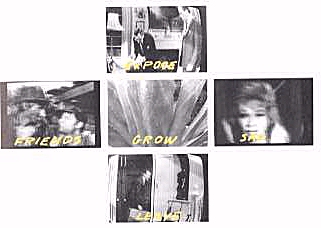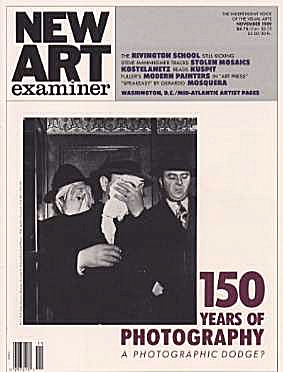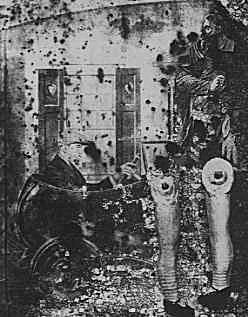Given my personal interest in Photo-Language issues (see frontispiece and back cover), I have always been drawn to John Baldessari's work as exemplifying many personal concerns of my own. Hence, when an opportunity arose to review his twenty-year retrospective, I looked forward to engaging the breadth of his work.

A Sentence of Thirteen Parts (With Twelve Alternative
Verbs) Ending in FABLE (detail, 1977) John BaldessariBut as I wrote, the discussion shifted past his work per se to engage the theoretical web woven by Coosje van Bruggen's catalogue essay; an enframing structure that constrained Baldessari's work largely within a reactionary late-modernist hermeneutic, enabling Van Bruggen to recoup Baldessari's artwork within the discourse of originality, personal angst, and collective archetype. Expecting Van Bruggen to read "Big John's" work through the lens of structuralism and poststructuralism, I was taken aback by her attempt to place Baldessari backwards into Modernism proper. I observe that:
"Even as Baldessari's art is made to speak — through the aegis of Van Bruggen's commentary and carefully chosen citations — of its naive, humble origins in the arid cultural and territorial margins of the Southwestern United States, his work asserts its sophisticated East Coast intellectual trappings. Van Bruggen's three essays analyze this marked intellectual component in Structuralist/Freudian terms, going after the latent meanings in Baldessari's work, probing its deep structure in ways that at once subjectify and universalize his aesthetic production. The Freudian triad of the superego, ego, and id; alchemy; the dream state; the richness of antithetical meanings; and symbols associated with Jung's collective unconscious are all appealed to in Van Bruggen's reading of Baldessari's work. This distances her discussion from poststructuralist explications which attack the "totality" of the ego and the mystical inflections of positing such a transhistorical entity as Jung's."
Thus, my review came to deconstruct Van Bruggen's critical frame, my main focus shifting from the center to the margins, from the ergon (the artwork itself) to the parergon (the frame, the stage that presents the work).
What Van Bruggen had failed to do was to elucidate Baldessari's work from within the very theoretical atmosphere most influential on his thinking (recall that Baldessari had once yearned to be a theoretician). So I wanted the next essay following upon "Cluing in to Baldessari" to sketch the range of contemporary theory. Hence, "A Critical Contest" explicates two recent and very important contributions to critical literature: the anthologies, The Critical Image (Carol Squiers, editor) and The Contest of Meaning (Richard Bolton, editor). In comparing and contrasting these two books, the reader is given a succinct overview of the shift in critical thought that has occurred over the last twenty years. Bolton's introduction explicates the territory the writings he has collected range over:"To gain a critical understanding of our complicated relationship to photography, we must not only analyze art photography, but also such photography first within the context of all photographic production, then within the context of information production, and then within the context of social production. For art photography is one small part of the extensive history of technological communication and the technological organization of reality. The writers in this book offer their arguments with these larger contexts in mind."
Bolton goes on to sketch out various new questions this anti-formalist criticism will address: "What are the social consequences of aesthetic practice? How does photography construct sexual difference? How is photography used to promote class and national interests?" and "What are the politics of photographic truth?" Implicit in the discussion of these questions attendant upon new approaches in criticism is the importance of defining the type of agent/structure relationship (dualism or duality) as the basis for one's theorizing. For instance, "the personal is political" of feminism empowers the social agent in ways that cannot occur under the structural determinism of Althusserian Marxism where the subject is "interpellated" (positioned) by discursive regimes.
Given the plethora of critical challenges to traditional art history and con- noisseurship—feminist, Marxist, neo-Marxist, and poststructuralist—how is one to take a blockbuster photographic exhibition and catalogue that, like Van Bruggen's essay, retreats into the hallowed halls of Modernism? "An Artful Dodge" examines one of the larger efforts by orthodox historians, during photography's much touted sesquicentennial, to contain the divisiveness of postmodernist photographic production and reassert the primacy of modernist historical development (a project not unlike Grundberg's):" 'On the Art of Fixing a Shadow: 150 Years of Photography' reins photographic history into line with the curatorial propensities of the photography department at the Museum of Modern Art, New York. It seems no accident — at a time when both the medium's "purity" is viewed by some as despoiled by miscegenation (alternative processes and/or politicized content) and the photographer's authorial status as an 'intelligent eye' is being undermined by rampant quotation and pastiche that this exhibition comes along to function as damage control. Conservatively recontaining the multiplicity of historical discourse and aesthetic production that actually characterizes the medium, the theorizing here, despite some new insights by the curators, is a twenty year step backward; it should have been a brave leap forward, a fresh rethinking of the complex socio-aesthetic phenomenon we reify as Photography into an examination of the discursive of various 'photographies'."
Upon publication, the original version of this essay was met with two responses: either I was not strident enough or I was wholly misguided. Of the latter camp, one of the show's curator's, Joel Snyder (University of Chicago), was particularly blunt in a letter to the editor sent to the New Art Examiner: "If Hugunin had not been so passionately committed to reducing all the essays [the four catalogue essays by the four curators] to a single corpse and then hacking it up with a borrowed rusty blade, he might have realized that he needed a different kind of stiletto to use on each of them. So instead of dissecting and criticizing, he merely mutilates." In my reply to Snyder, I attempted to clarify the matter. However, in re-reading the essay, I decided to rewrite it for this anthology in order to more thoroughly answer Snyder's objections; the revision, then, increasingly particularizes my engagement with each of the curator's essays. However, no fundamental shift has occurred in my original position vis-à-vis the exhibition.

The New Art Examiner (Nov. 1989) issue featuring the
original review of the show "The Art of Fixing a Shadow"Another blockbuster exhibition, installed at several major museums in Chicago, was visited upon the Windy City in 1989. Philanthropist-photographer Jack Jaffe's Focus/Infinity Fund helped underwrite a massive documentary photographic project that was to visually reassess the Chicagoland area some fifty years after the Farm Security Administration document was made. Here the factuality of the contemporary social agent inhabiting the post-industrial, rust-belt landscape was the proposed subject matter. My essay, "Retro-Doc: Nostalgia Obscures 'Changing Changing'," asks how well this was accomplished, while it addresses the contemporary attack on traditional humanistic photo-documentary (as leveled by Allan Sekula and John Tagg), and its replacement with the "new documentary," i.e., poststructuralist and neo-Marxist inflected critical interventions of the likes of Victor Burgin, Barbara Kruger, Fred Lonidier, Martha Rosler, and Allan Sekula. As pertaining to traditional documentary, I observe that:
"This 'documentary-style' of photographing tacitly assumes a specific philosophy: there is a real world which is independent of consciousness and ideology, and which is accessible through sense-experience — the territory is out there already, waiting for us to simply map it onto the surface of photographic film in a point-for-point analogue corres- pondence. This is akin to an empiricism which posits a receptive subject upon which sense data imprints itself. The validation of knowledge (fact) within this epistemology is based upon the correspondence between two realms: between the territory and the map, that is between the world of events, objects, and relationships and their representation in visual form."
This is contrasted to:"The alternative forms of socially committed art — the postmodernist internal critique and the neo-Marxist photo-language approach — [that] are rooted in a vigorous critique of the very empiricist premises upon which traditional documentary has built its accomplishments. Both eschew the purely optical record of a visual reality that one hopes will stir people's consciences toward social change."
The reader will find that my discussion in this essay concerning these two opposing strategies of social critique will also elucidate my earlier engagement with Lou Stoumen's use of photography to produce his (Human) Family Album.
The dilemma presented by photography's supposed dualism — subjectivity/ objectivity — repeats the sociologist's dilemma of the agent/structure relationship. Stoumen's subjective concerns with the seemingly "objective" photographic image and Jaffe's touting of personal documentary's ability to reveal some kind of social essence already broaches the issue. "Subjektive Fotographie and the Existentialist Ethic," takes up this dilemma as its explicates how formally-similar photographs, culled from 1920s and 1950s German photography, came to be framed within seemingly opposed discourses: the 1920's New Vision photography being touted for its harsh camera-eye "objectivity," while the 1950s subjektive fotographie was said to express very personal perspectives. An analysis of Husserlian Phenomenology and Sartrean Existentialism is paired with an examination of imagery, documents, and social context showing the influence of these philosophical positions on the periods under discussion; for instance, I note that:"Theoretically, subjektive fotographie could draw from phenomenology's positing of the mutual implication of subject and object, from the phenomenological method that involves intending, intuition, reflection, and description of phenomena. Phenomenology, like subjective photography, stressed how one subjectively intends and constitutes one's 'life-world.' Both espouse making a transition from a natural, non-reflexive perception of things to an intensified, self-reflexive grasp of key aspects. Like existentialism, it put an emphasis on subjective knowledge, knowledge constituted by feelings and desires, as well as thought as played out in specific 'situations.' Like Jean-Paul Sartre's, Steinert's theorizing stresses the constituting power of the gaze, and the importance of authenticity: a creative, personal individuality opposed to inauthenticity, 'bad faith' or mauvaise foi in Sartre's terminology."
I argue how Dr. Otto Steinert's theorizing of a subjektive fotographie led to not only an aesthetic, but to an ethic (rooted in a particular understanding of the relation between the social agent and the constraints of his or her "situation") expressed in existentialist theory and literature. I then accuse this ethic of hubris, opposing it to the limitization and relativization characteristic of our postmodernist times:"Such self-confidence marked the beginnings of subjective photography, but today self-denial and self-questioning mark our postmodernist aesthetic. We deny originality its romantic pretensions and question the application of the term 'genius' to authorship. Once frowned upon as aesthetic 'bad faith,' pastiche and appropriation are now the norm.... Instead of the unique viewpoint, the 'decisive moment,' our sensibility now sanctions re-photography. An exploration of the tenets of subjective photography permits us to see more clearly the aesthetic and ethical gap between Otto Steinert's subjectivized images and Sherrie Levine's scavenged (rephotographed) photographs, reminding us of the gap between modernism then and postmodernism now."
The discussion of these issues is situated within the context of a Germany divided into four occupied zones — United States, France, Britain, and the Soviet Union — and undergoing de-Nazification, as well as the formation of the economic, social, political, and militaristic tension between capitalistic and communistic world views which was to lead to the building of the Berlin Wall between East and West Germany. Translated into the economic sphere, such touting of aesthetic individuality, I observe, underwrites the ventures of the capitalist entrepreneur:"Linked to this autonomous individual and to the emphasis on formal issues is the modernist hope that photography itself become a uniquely expressive medium, an autonomous signifier, such as painting became with Abstract- Expressionism. Like the Abstract-Expressionist brush-stroke, the formal conventions of subjective photography signified the reconstitution of freedom and individuality of expression after a devastating war during which people on both sides suffered restrictions to their personal agency. This freedom, according to Sartre, is based on the negating power of consciousness, which can be seen as analogous to the limiting, negating power of the edges of the photographic frame. Freedom, in both Steinert's and Minor White's aesthetic means the possibility of seeing things other than as they are. . . . One can see how ideo- logically useful this philosophy might become in an era just leaving behind the repressive horrors of the Third Reich, an era of renascent capitalism now facing the ideological and military threat of Communist East Germany at the advent of the Cold War."
In West Germany, such specific historical conditions inflected the nature of what was considered politically acceptable. Photography was not the only practice affected. For instance, in a study of Theodor Adorno and the Frankfurt School of Marxism, Martin Jay in Adorno (1984) points out that when that School's famous Institute for Social Research returned to Frankfurt from exile in New York during World War II, it exercised what director Max Horkheimer thought prudent self-censorship in suppressing its earlier pro-Marxist, anti-capitalist theoretical bent: "As early as 1951 [the date of the first exhibition of 'subjektive fotographie'], members of the Institute who remained in America had noted a subtle change in its orientation" from Critical Theory to an increasing reliance on empirical research. The Institute director defensively replied to the School's contingent that had remained in America, "We stand here for the good things: for individual independence [my emphasis]. . . . Symbolic of Horkheimer's caution was his decision to keep the more politically explosive volumes of Zeitschrift[the Institute's journal], according to [Jürgen] Habermas, 'in a crate in the Institute's cellar, nailed shut, and out our grasp'."Adorno disagreed with Horkheimer on this issue of bourgeois individuality. In The Jargon of Authenticity (1973) Adorno leveled an attack on existentialism's fetishizing of individuality. Martin Jay succinctly synopsizes the crux of Adorno's argument: "Rather than negating the alienation of modern life, the jargon of authenticity was one of its more subtle manifestations." Adorno would have seen subjektive fotographie's "authenticity" as actually producing a set of easily replicated conventions that really did not escape the mechanisms of the culture industry. Thus, the touting of subjective expression by art professionals and the photographic industry only generated — writes Jay, interpreting Adorno — "a pseudo-aura to give the effect of individuality to what in fact were totally standardized commodities."
In 1987 I was asked to contribute an essay to a large tome, a critical homage to the photographic work of octogenarian Frederick Sommer. The project never materialized, but as a result I did find on my hands a rather lengthy and arcane series of meditations I wrote on Sommer's work. The meditations are filtered through psychoanalytically-oriented theory, specifically D. W. Winnicott's Object Relations Theory and his notions of "transitional phenomena," and Julia Kristeva's revision of Jacques Lacan's re-reading of Freud. Julia Kristeva's conceptions of the agon between the semiotic (the subversive irruption of the primary processes) and the symbolic (the repressive secondary processes, the structure of language and symbolization) constitutes a mutually implicated duality that is analogous to the agency/structure debate. Sommer's work, despite its "politically incorrect" philosophical underpinnings, has continued to fascinate me.

Untitled (1950) Frederick SommerMy meditations attempt to theorize my divided-self; as Spanish philosopher Miguel de Unamuno so aptly put it: "The contradiction of my heart that says Yes and of my head that says No!" In making such an attempt, I try to think out a new way to understand Sommer's work, other than within the discredited context of the New Criticism, the critical topos employed in Aperture magazine, specifically by Minor White and Henry Holmes Smith:
By now my fingers are thumbing through Eagleton's book, Against the Grain (1986), in search of the passage that part of me doesn't want to find. Yet, hastily scribbled marginal notes and red gashes beneath lines of text guide me relentlessly toward my destination. I find the specific reference and read: 'To fend off such reduction to commodity status, the modernist work brackets off the referent or real historical world, thickens its textures and deranges its forms to forestall instant consumability, and draws its own language protectively around it to become a mysteriously autotelic object, . . .' This thickening of texture and derangement, I saw it again and again in Sommer's photographs. In the pages of Aperture, I observed the attempts to prolong the act of photographic communication, to cloak the image in esotericism, and move it toward the kind of autonomy Eagleton mentions above. But I also sensed how Sommer's development of an intermediate space analogous to Winnicott's understanding of subject-object interaction mitigated against the full assumption of his photographs into such an autotelic, objectified state. I reopened Winnicott's text and read how the transitional object is not an internal object (which is a mental concept ) — it is a possession — yet how it is not, for the infant, an external object either. I felt somewhat reassured.